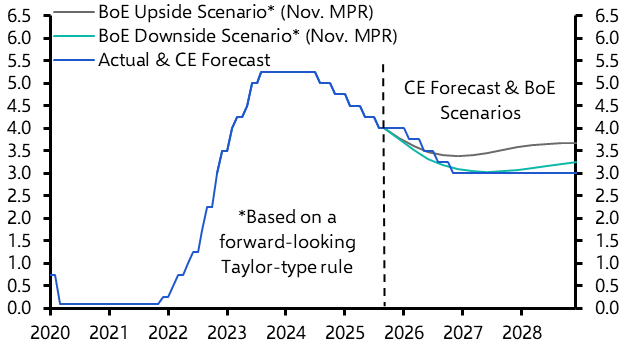Financial markets love a good story. Twelve months ago, the dominant narrative was that we were heading into another “Roaring Twenties”, with the global economy set to see years of above-trend growth as it emerged from the pandemic. What a difference a year makes: the narrative has now flipped as concerns about recession have spread. Is this latest story any more convincing than last year’s?
Recession fears have focussed on the US and were triggered by a brief inversion last month in the spread between 2 and 10 -year US Treasury yields. Inversions occur when yields on short-dated bonds rise above those of long-dated bonds – thus “inverting” the usually upward-sloping yield curve. There is no mechanical link between an inverted curve and the real economy. Instead, the significance of an inverted curve stems from the fact that it reflects the collective wisdom of deep and liquid bond markets. And when long-dated yields drop below short yields it’s because these markets are anticipating that central banks will need to loosen policy to support a slowing economy.
The curve has inverted ahead of every recession in the US over the past 50 years, with only one false positive (in 1998). It’s therefore about as good a recession indicator as we’re going to get. Ignoring the yield curve means betting against history.
However, the problem today is that the yield curve has been distorted by the effects of large-scale central bank asset purchases over the past decade. These have compressed term premia and pulled down yields at the long end of the curve, thus making it more prone to inverting. We therefore suspect that the yield curve may have lost some of its predictive power.
More fundamentally, there are few signs of the large imbalances in the US economy that have typically preceded recessions. In particular, household balance sheets are unusually strong. A few weeks ago, I noted that soft landings are rare, but the strength of household balance sheets provides grounds for optimism this time.
It’s possible that tighter policy combined with a further easing of post-COVID supply frictions causes the US economy to cool without precipitating a recession. A US recession is still possible, particularly if policy tightening causes an unexpected and sudden tightening in financial conditions. (The effects of quantitative tightening are still largely unknown.) But, as we noted in our latest US Outlook, the most likely outcome is a protracted period of below-trend (and below-consensus) growth.
If a recession does materialise, it is more likely to do so in Europe than in the US. This is for two reasons. The first is that trend growth is lower in Europe. We estimate that potential GDP growth in the euro-zone is around 1%, compared to nearly 2% in the US. One consequence of Europe’s lower trend rate of growth is that it doesn't take much to blow the economy far enough off course to produce a drop in output.
The second reason is that Europe is a larger net importer of commodities than the US, meaning that the surge in global commodity prices over the past few months has caused a much greater deterioration in its terms of trade. As a result, households in Europe are now facing a much larger squeeze in their real incomes. (See Chart.)
Chart 1: US & Euro-zone Real Household Disposable Incomes (Q4 2019 = 100)

This squeeze in real incomes is a key reason why our Europe team thinks the euro-zone could record small quarterly falls in GDP in the first three quarters of this year. (See Chart.) If there were outright falls in output, they would be small and short-lived, particularly by recent European standards. But two successive quarters of falling output would nonetheless fulfil one widely accepted definition of a technical recession.
Stepping back, two points are worth making. First, the speed at which the market narrative has switched from the “Roaring Twenties” to the “Recessionary Twenties” illustrates the dangers of being seduced by simple stories. The reality is invariably more complicated and nuanced than the prevailing narrative suggests.
Second, the fixation on whether a particular economy will experience a recession misses the bigger picture. The difference between an economy seeing miniscule contraction for two successive quarters, and therefore fulfilling one definition of recession, and flatlining for two successive quarters, and therefore escaping recession, is negligible. The more important point is that, with or without a recession, the performance of the world’s major economies is likely to be weaker than most currently anticipate. That was a central plank of our key calls at the start of this year, and developments in the first quarter have only reinforced our belief that 2022 will be a year in which most economies struggle.
This is a theme which we’ll be revisiting – alongside with updated forecasts – in our second quarter Global Economic Outlook this week.
In case you missed it:
- Our Europe team’s Q2 Economic Outlook warned of “a year of stagflation” as the ECB tightens monetary policy, even as the war in Ukraine takes its toll on growth.
- Why we think the Chinese renminbi and Japanese yen have further to weaken.
- Marcel Thieliant warned that markets are overestimating the impact of Reserve Bank of Australia rate hikes, so are underestimating how high rates have to go.



